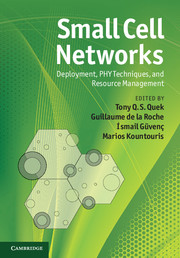Book contents
- Frontmatter
- Contents
- List of contributors
- Foreword by David Chambers
- Acknowledgments
- Acronyms
- 1 Small cell networks overview
- 2 Fundamentals of access control in femtocells
- 3 Coverage analysis using the Poisson point process model
- 4 Interference modeling for cognitive femtocells
- 5 Multiple antenna techniques in small cell networks
- 6 Physical layer techniques for cognitive femtocells
- 7 Femtocell coverage optimization
- 8 Random matrix methods for cooperation in small cell networks
- 9 Mobility in small cell networks
- 10 Cognitive radio resource management in autonomous femtocell networks
- 11 Decentralized reinforcement learning techniques for interference management in heterogeneous networks
- 12 Resource allocation optimization in heterogeneous wireless networks
- 13 New strategies for femto-macro cellular interference control
- 14 Femtocell interference control in standardization
- 15 Spectrum assignment and fairness in femtocell networks
- 16 Self-organization and interference avoidance for LTE femtocells
- Index
- References
8 - Random matrix methods for cooperation in small cell networks
Published online by Cambridge University Press: 05 May 2013
- Frontmatter
- Contents
- List of contributors
- Foreword by David Chambers
- Acknowledgments
- Acronyms
- 1 Small cell networks overview
- 2 Fundamentals of access control in femtocells
- 3 Coverage analysis using the Poisson point process model
- 4 Interference modeling for cognitive femtocells
- 5 Multiple antenna techniques in small cell networks
- 6 Physical layer techniques for cognitive femtocells
- 7 Femtocell coverage optimization
- 8 Random matrix methods for cooperation in small cell networks
- 9 Mobility in small cell networks
- 10 Cognitive radio resource management in autonomous femtocell networks
- 11 Decentralized reinforcement learning techniques for interference management in heterogeneous networks
- 12 Resource allocation optimization in heterogeneous wireless networks
- 13 New strategies for femto-macro cellular interference control
- 14 Femtocell interference control in standardization
- 15 Spectrum assignment and fairness in femtocell networks
- 16 Self-organization and interference avoidance for LTE femtocells
- Index
- References
Summary
Introduction
We are currently witnessing an exponentially increasing demand for wireless data services, which is mainly driven by the growing popularity of wireless modems, smartphones, and tablet personal computers (PCs). Not surprisingly, current cellular networks have already started reaching their capacity limits in densely populated areas and it is therefore necessary to assess which network architecture is most suited to carry the future data traffic. As additional spectrum resources are scarce, it seems inevitable that any future system architecture will rely to a significant extent on network densification, i.e., an increase of the number of antennas deployed per unit area. This can be achieved by either increasing the number of antennas per base station (BS) [1] or by deploying more BSs [2], or a combination of both [3]. More antennas per device lead to additional degrees of freedom, which can provide spatial multiplexing and diversity gains or can be used to cancel interference [4]. On the other hand, a denser deployment of BSs, such as femto or small cells [5], increases the spatial reuse of the radio spectrum. Although the network capacity would theoretically scale linearly with the BS density, dense networks suffer from increased inter-cell interference and user mobility becomes difficult to manage. The cooperation of multiple BSs, which jointly process user data from multiple cells [6] has shown its potential to counter inter-cell interference and to improve the cell edge coverage not only in theory [7] but also in practice [8]. Base station cooperation is therefore already considered as an essential feature of future cellular standards [9]. Apart from that, clusters of cooperating BSs forming virtual cells could also potentially reduce the amount of handover signaling between cells to enable user mobility in dense networks [10].
- Type
- Chapter
- Information
- Small Cell NetworksDeployment, PHY Techniques, and Resource Management, pp. 188 - 218Publisher: Cambridge University PressPrint publication year: 2013

